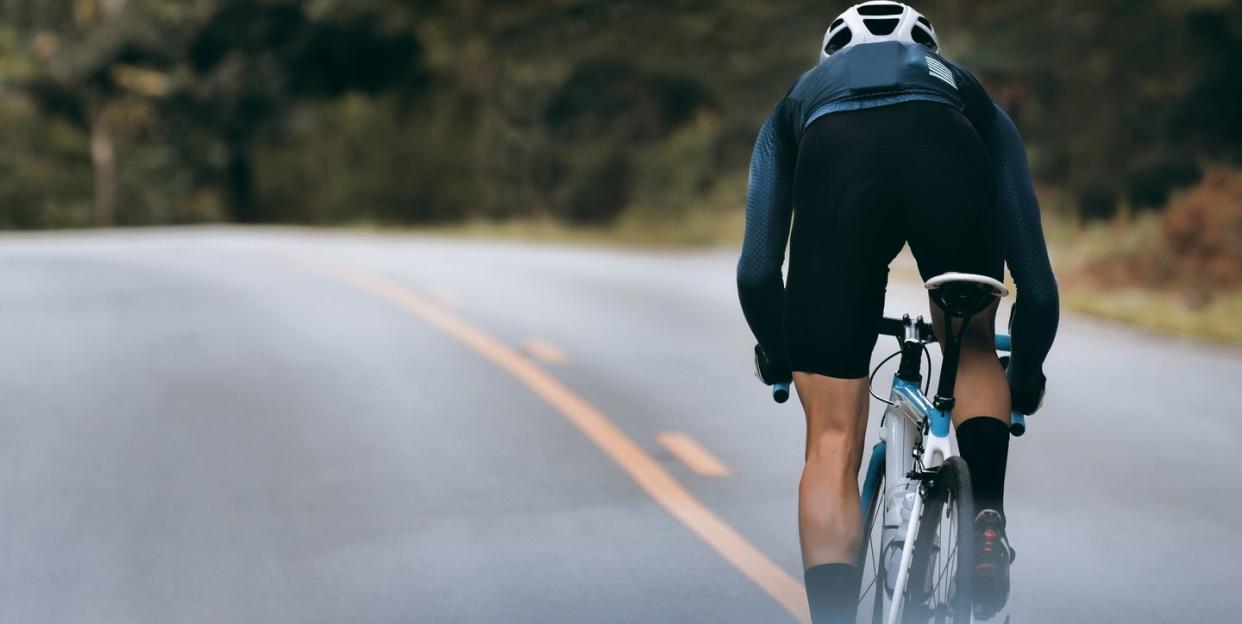Your Body Fat Percentage Can Be a Way to Measure Your Health

One of the most common measures we all strive to maximize at some point or another is our power-to-weight ratio (PWR). Your PWR is the amount of power that can be produced in relation to your body weight, usually expressed in watts per kilogram. The higher your power-to-weight ratio, the easier it will be to pedal and the faster you can go. But if you don’t have enough weight, you might end up being too weak to power through. And that’s where understanding your body fat percentage comes in.
What Is Body Fat Percentage?
Your body fat percentage refers to what percent of your body is made up of fat versus the weight that comes from your muscles, bones, and organs. “Some body fat is visible as subcutaneous fat just below the skin, while other body fat surrounds our organs and is used to sheath nerves and the brain,” explains John Martinez, M.D., a sports medicine physician who has worked with the USA Triathlon National team.
In terms of your health, your body fat percentage should fall within a certain range. These are the age-adjusted body fat percentile recommendations health pros use:
Men:
Essential Fat: < 5 percent
Athletes: 5 to 10 percent
General Fitness: 11 to 14 percent
Good Health: 15 to 20 percent
Overweight: 21 t0 24 percent
Too High: > 24
Women:
Essential Fat: < 8 percent
Athletes: 8 to 15 percent
General Fitness: 16 to 23 percent
Good Health: 24 to 30 percent
Overweight: 31 to 36 percent
Too High: > 37
Obviously, you need some fat to survive. But to put it simply, “a lean, strong cyclist can move quicker than a heavier, just-as-strong cyclist,” explains Natasha Trentacosta, M.D., a sports medicine specialist and orthopedic surgeon at Cedars-Sinai Kerlan-Jobe Institute in Los Angeles. “The excess fat simply slows you down. Having less fat tissue means that your muscle tissue has less competition for oxygen and fuel, which will increase aerobic capacity. This is why competitive road cyclists are some of the leanest athletes around.”
You also need muscle to power your bike. And if you’re shedding too much weight, or you’re burning through limited fat and glucose stores too fast, your body will actually start to break down your muscles for fuel—and that’s going to mess with your performance.
How to Calculate Body Fat Percentage
There are a bunch of tools to calculate body fat percentage, but not all of them are a.) accessible or b.) affordable. The most accurate of them involve pods, tanks, or machines you’re most likely to find at a sports performance or medical clinic, says Martinez. For example, DEXA Scan is a 10-minute scan that quantifies your body composition; hydrostatic (dunk tank) testing measures body fat percentage by calculating the amount of water displaced when you’re fully immersed under water; and the BOD POD measures the volume of air displaced instead of the volume of water displaced. Three dimensional scanners like Fit3D calculate body fat percentages from 3D imaging of the body, and electrical impedance measurements send a low-level electrical current through the body to see how it’s conducted through muscle, bone, and fat.
More common is the good ol’ skin caliper method, which, if it’s done by a trained sports medicine professional or certified physical trainer, can give a close approximation of body fat percentages but requires good technique to get accurate measurements. The next most common is the electric impedance measurement of body fat percentage, a calculation many home scales can now do (but the accuracy is significantly affected by hydration status).
Of course, you can always use an online calculator for an approximation of your body fat percentage, too.
How to Change Your Body Fat Percentage
If you’re interested in shifting your body composition by reducing your body fat percentage—whether for health or performance reasons—there are two broad but guaranteed ways to do it: changing your dietary habits or changing your workouts.
Improving your diet to optimize low body fat is not quite as simple as just reducing the calories in versus calories out, but that is a simple place to start. To do that, you want to eat high-quality foods such as fruits, vegetables, lean proteins, nuts, low-fat dairy, and omega-6 and omega-3 fatty acids. “Choosing a high-protein and high-fiber diet, and limiting trans fats and refined carbohydrates can efficiently promote lean body mass and limit fat storage,” Trentacosta says.
In regards to workouts, strength training can help you increase lean muscle mass and increase your power output. “Recent studies have shown that maximal strength training, using high loads with few repetitions, may prove beneficial,” says Trentacosta. “The main goal of strength training in cyclists is to create a solid foundation for the integral muscle groups required in cycling: You want your lower [body] and core to be aerobically stronger for you, so as to prevent or delay fatigue in long races and increase overall power on the road.”
[Want to fly up hills? Climb! gives you the workouts and mental strategies to conquer your nearest peak.]
Adding two 30-minute sessions of strength training can help you see the kind of gains you’re looking for here, especially if you’re using weights. “Lifting weights is better than bodyweight workouts alone in challenging the body as you advance in a strength training program,” says Trentacosta.
The way you ride can also affect your body fat percentage. Performing high-intensity interval training, or HIIT for short, can boost your aerobic and anaerobic fitness, improve insulin sensitivity, and burn off fat, all while helping you maintain lean muscle mass, and of course, make you faster and stronger on the bike.
You Might Also Like

